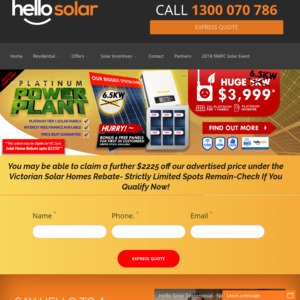Fully Installed 6.5 kW Solar Panels & Inverter $3,999 (or $1999.50 $1,774 after Victorian Solar Home Rebate of 50% $2,250) Victoria Only
275W TIER 1 SOLAR PANELS- We only use Certified Tier 1 Solar Panels - Manufactured by the best in the business.
Platinum Tier 1 Panels- Designed specifically for optimal performance to combat the unpredictable Australian climate. Utilise their industry leading warranty and 48 hour warranty fulfillment and Positive Quality' by the Australian Solar Council.
PLATINUM AC BATTERY READY INVERTER - Prepare for the future of solar with our battery compatible inverters. All systems come battery ready so you are not left behind when solar storage options become more affordable.
The Hello Solar Dashboard provides a personalised and comprehensive analysis of your own system's performance. - Easy to use and hosted in the cloud, you can access your dashboard at any time from your computer, tablet or smartphone. See how the system is performing and even get immediate alerts for when it's not - Making it easier to diagnose and resolve issues promptly.
LIFETIME WARRANTY - We are so confident in the components supplied and the professionals installing them that we offer a Lifetime Warranty on the workmanship. Live with peace of mind that the installation is protected for a lifetime.
Melbourne Office: Level 8, 90 Collins Street, Melbourne VIC 3000; P: 1300 070 786
E: [email protected]
Sydney Head Office: Suite 2/25 Solent Circuit; BAULKHAM HILLS NSW 2153; NSW Contractor License No: 307439C
Adelaide Office: Level 5, City Central, Tower 2; 121 King William Street; Adelaide, South Australia 5000
![[VIC, NSW, SA] Fully Installed 6.5 kW Solar Panels & Inverter $3,999 (or $1,999.50 after 50% VIC Solar Rebate) @ HelloSolar](https://files.ozbargain.com.au/n/03/402003.jpg?h=1b876fab)

Interested in solar for NSW to offset the costs for the family. Someone in the know: is his a good deal?